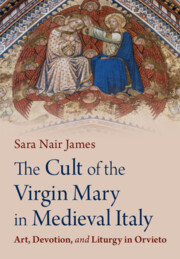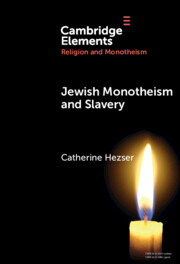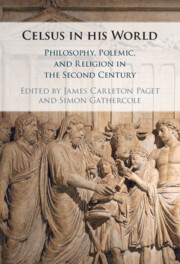Refine search
Actions for selected content:
43 results
Chapter 7 - Leviticus in the Old Testament and Beyond
-
- Book:
- The Theology of the Book of Leviticus
- Published online:
- 18 July 2025
- Print publication:
- 07 August 2025, pp 234-262
-
- Chapter
- Export citation
1 - Pagan Architecture
- from Part I - Architecture and Iconography
-
- Book:
- The Cambridge Encyclopaedia of Late Antique Art and Archaeology
- Published online:
- 04 July 2025
- Print publication:
- 31 July 2025, pp 9-27
-
- Chapter
- Export citation
18 - Glass
- from Part II - Artefacts and Evidence
-
- Book:
- The Cambridge Encyclopaedia of Late Antique Art and Archaeology
- Published online:
- 04 July 2025
- Print publication:
- 31 July 2025, pp 349-359
-
- Chapter
- Export citation

The Cult of the Virgin Mary in Medieval Italy
- Art, Devotion, and Liturgy in Orvieto
-
- Published online:
- 24 July 2025
- Print publication:
- 24 July 2025
20 - The Reception History of Isaiah
- from Part IV - Afterlives of the Book of Isaiah
-
-
- Book:
- The Cambridge Companion to the Book of Isaiah
- Published online:
- 08 November 2024
- Print publication:
- 21 November 2024, pp 326-344
-
- Chapter
- Export citation
32 - The African Gold Coast Essay: Straddling Fact and Prophecy
- from Part IV - Fractured Selves, Fragmented Worlds
-
-
- Book:
- The Cambridge History of the British Essay
- Published online:
- 31 October 2024
- Print publication:
- 04 July 2024, pp 483-496
-
- Chapter
- Export citation
5 - The Sermon and the Essay
- from Part I - Forming the British Essay
-
-
- Book:
- The Cambridge History of the British Essay
- Published online:
- 31 October 2024
- Print publication:
- 04 July 2024, pp 63-76
-
- Chapter
- Export citation

Jewish Monotheism and Slavery
-
- Published online:
- 19 February 2024
- Print publication:
- 14 March 2024
-
- Element
- Export citation
Chapter 1 - Introduction
-
-
- Book:
- The Cambridge Critical Guide to Latin Literature
- Published online:
- 04 January 2024
- Print publication:
- 18 January 2024, pp 1-42
-
- Chapter
- Export citation
29 - Alexander in Jewish and Early Christian Literature
- from Part IV - The Ancient World’s Memory of Alexander
-
-
- Book:
- The Cambridge Companion to Alexander the Great
- Published online:
- 04 January 2024
- Print publication:
- 18 January 2024, pp 471-487
-
- Chapter
- Export citation
27 - Digital Religion
- from Part III - Activities in Cyber Behavior
-
-
- Book:
- The Cambridge Handbook of Cyber Behavior
- Published online:
- 06 December 2024
- Print publication:
- 09 November 2023, pp 791-806
-
- Chapter
- Export citation
10 - Which words were borrowed?
-
- Book:
- Latin Loanwords in Ancient Greek
- Published online:
- 25 May 2023
- Print publication:
- 15 June 2023, pp 623-650
-
- Chapter
- Export citation
Chapter 15 - Patience
- from Part II - Shakespeare’s Virtues
-
-
- Book:
- Shakespeare and Virtue
- Published online:
- 19 January 2023
- Print publication:
- 26 January 2023, pp 155-163
-
- Chapter
- Export citation
9 - Christian Theological Interpretation
- from Part II - Frameworks/Stances
-
-
- Book:
- The New Cambridge Companion to Biblical Interpretation
- Published online:
- 15 October 2022
- Print publication:
- 22 December 2022, pp 173-190
-
- Chapter
- Export citation
6 - Religion and Ethnicity
-
- Book:
- Arabic Sociolinguistics
- Published online:
- 01 July 2022
- Print publication:
- 07 July 2022, pp 106-130
-
- Chapter
- Export citation
7 - Matters of Faith
-
- Book:
- Survivors
- Published online:
- 27 January 2022
- Print publication:
- 17 February 2022, pp 192-225
-
- Chapter
- Export citation
Chapter 12 - The Eternal Return
- from Part II
-
- Book:
- The Christian Invention of Time
- Published online:
- 13 January 2022
- Print publication:
- 03 February 2022, pp 267-313
-
- Chapter
- Export citation
8 - The Gospel according to Celsus
-
-
- Book:
- Celsus in his World
- Published online:
- 18 November 2021
- Print publication:
- 25 November 2021, pp 254-296
-
- Chapter
- Export citation

Celsus in his World
- Philosophy, Polemic and Religion in the Second Century
-
- Published online:
- 18 November 2021
- Print publication:
- 25 November 2021
2 - Interaction
-
-
- Book:
- Analysing Religious Discourse
- Published online:
- 18 June 2021
- Print publication:
- 08 July 2021, pp 12-31
-
- Chapter
- Export citation
